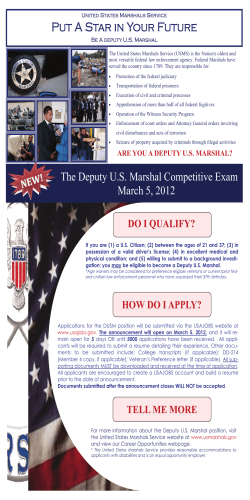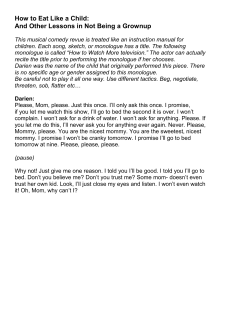
Officials Newsletter 2014 Formula 1 Rolex Australian GP IT’S A BRIGHT WEEKEND
Officials Newsletter 2014 Formula 1 Rolex Australian GP IT’S A BRIGHT WEEKEND JASON BRIGHT, V8 driver of No.8 BOC Holden for Brad Jones racing, had what you might say was a little accident last weekend at Clipsal. He said “I think there were a couple of things that went wrong. One was that the new restart rule we have was not followed by the leading cars, and with the rest of us were relying on the engineers to tell us when to go. There was a big concertina which created many cars side by side into Turn One. Following that my left rear wheel hit GARTH TANDER’s right front wheel, putting me up on two wheels and then rolling a couple of times.” Jason’s first thought after he landed was “Oh great. I have to get out of this thing upside down!” This was quickly followed by “The engine was still running” and then “I hope we don't have any fuel leaking!” In describing the rescue efforts, Jason said “While hanging upside down, unplugging the many things we have connected such as cool suit, radio, drink bottle, helmet air, I had a Marshal lying on the ground at the passenger window asking if I was ok. He then helped guide me out the passenger window which was the only way out. From there the medical team took me to the Medical Centre for a check, while the rest of the Marshals turned my car back over and loaded it onto a truck” Jason talked about his car and how safe it was. “The car stood up reasonably well; and V8 Supercar and the teams study damage in each accident and look to see whether it really has done its job. The most damage to the chassis was done on the final landing. With regards to the driver safety area, I think things such as our location being much more central these days really helped in such an accident and mean I wasn't thrown as much as you previously would be. My head was also very well protected by the seat and the distance we have to any roll cage. The safety equipment Jason uses include Willans harnesses, Race Tech seat, which is mounted to the floor, and roll hoop to hold it much more securely. His other gear, like Arai helmet, was protected well from the way he was positioned in the car. “It is also compulsory for all of use to wear the HANS Device, although in this kind of accident it wouldn't have done a lot I don't think.” Jason said “I was totally fine. It looked much more spectacular than what it felt.” Jason and the Brad Jones Racing team received lots of support on Facebook, so as a Thank You, the team decided to ask them to leave their name if they wanted it on the rear wing of our car. The team received more than 1500 names, including Jason’s teammate, FABIAN COULTHARD. Jason is driving a different car this weekend. He said “This is a completely new chassis. Fortunately we had this one come off the jig just at the right time. A big crash like this last year may have been a bigger challenge.” Jason had good words for the marshals. “Thank you all for your support and hard work at each and every meeting!” Officials Newsletter – Friday 14th March 2014 – Formula 1 Rolex Australian Grand Prix WORDS WITH CHARLIE Wednesday afternoon with FIA F1 Race Director, CHARLIE WHITING, has become a standing appointment prior to the AGP weekend. By then he and the other FIA F1 officials have completed all the mandatory F1 track inspections and all is good. After all the years of Charlie coming to Australia as Race Director, he finds it somewhat difficult to come up with new ways of saying how much he enjoys working with the Australian marshals. He values the CAMS officials, their enthusiasm, experience, expertise and skills. CAMS have been given the contract to train the Russian officials for the upcoming Russian F1 GP in Sochi on 12 October 2014. Charlie said that speaks well for the talent amongst the CAMS officials and marshals, whose Training Teams have also worked with Grand’s Prix officials in Bahrain, Singapore, and Korea. This year the trackside light boards used by the marshals may look somewhat familiar. FIA has gone back to using the vendor who supplied them in 2012. There will be no changes in the ways the marshals respond to the F1 cars, despite all the new changes in the engines and energy recovery systems. There will still be the old KERS status light on the roll hoop - red, green and amber. There is a new exterior light on the car. Charlie doubts that, while allowed, any reserve or test drivers would be participating in the first Friday practice session. Most teams are eager to have as much track time as possible with the new cars and all the changes. The teams have to nominate their drivers by 4pm Thursday. There are many changes in the cars this year, which make them much more complicated pieces of machinery. When something breaks it takes a long time to replace, such as a battery which is mandated to be under the fuel tank. Charlie said he (and FIA) doesn’t know yet what challenges they will face with the new cars until after the cars are on track. One thing for sure will be the extensive record-keeping on all the engines which must be tracked and sealed. With all the allowed mix and matching, accurate and extensive recording is required, which will be handled by FIA officials, including JOE BAUER FIA F1 Technical Delegate and his staff. In the highly unlikely event that no F1 cars finish the race Sunday, the race will be Red Flagged when the last car stops, and the timing results will revert to the penultimate lap for scoring. Those cars finishing with 10 percent of the completed laps will be classified. If less than 75 percent of the laps have been completed, half points will be awarded. Conversely, if more than 75 percent of the laps have been completed, full points will be awarded. ALEXANDER ROSSI, the American driver, has been granted his 2014 Super Licence, as he will be the Test/Reserve driver for Caterham. Charlie has seen the RON HOWARD F1 movie, “Rush” and really liked it. He especially thought the two main characters - JAMES HUNT and NIKI LAUDA, were well portrayed. Having known both drivers well, Charlie was amazed how well the actors, especially DANIEL BRUHL, captured the personality of the drivers. Australia is one country, if not the only country, which has had the same Clerk of the Course since the inception of its event. TIM SCHENKEN has been the AGP Clerk of Course since 1985, the year Australia again began conducting a World Championship Grand Prix. But Australia’s GP history dates back 79 years, with two of the early ones being held in 1953 and 1956 in (the old) Albert Park. Last year at AGP CAMS celebrated the sixtieth anniversary of racing in Albert Park. Other long-time Grand’s Prix, such as those in Monza, Monaco and England have held races longer but their stewards have changed. Boundary Riders is an Aussie Officials Team originating in Adelaide and maybe one of, if not the, first such team for a F1 race. The roving assigned motorcycle riders were designed to rescue stranded drivers in a rush to get back to the garage. They knew all the back roads and ways to avoid paparazzi. Nowadays with no backup cars the urgency to return to the garage isn’t the same. The riders serve other functions as well, such as delivering supplies, moving personnel, and the like. Charlie said all the new race tracks built in the past few years have complete ring/service roads making for easier access. While English is the official language of FIA, there have been instances in Race Control where the local Clerk of the Course has had an interpreter. Japan is one such country. It could be that this will also be the case in Russia. Jokingly I asked if there was one for English to Australian. ☺ OfficialsNewsletter Newsletter––Friday Friday14th 14th March March 2014 2014 –– Formula Formula 11 Rolex Rolex Australian Australian Grand Grand Prix Prix Officials TECHNICALLY SPEAKING MICHAEL The 2014 Formula 1 season sees a great many changes to the regulations. Some are made in the name of safety, while others are to improve the green technologies used within the sport. The most obvious change is on the outside with the nose of the car dropping dramatically, with an unfortunate sideeffect to aesthetics. Some teams have made a proboscis, while others such as Ferrari and AMG Mercedes have more of a ski ramp. This is to improve the safety of the drivers in an accident, with the high noses of previous years hitting too high on other cars. The front wing width has been reduced by 150mm. The air passing over the front wing affects the aerodynamic performance of the entire car. While it’s a small change to spectators, it creates a large headache for aerodynamicists in each team. The most significant change has been at the back of the car with the propulsion system. No longer is it merely an engine, but now a Power Unit. Each Power Unit is made up of 6 components. As is typical of Formula 1, they can’t make simple names… ICE – The engine – Now a 1.6 litre V6 with a turbo. Rev-limited 15,000rpm (down from 18,000 last year), this changes the sound of the engines to a lower pitch. Many will miss the screaming V8s. There is also mandated a single exhaust pipe that must exit centrally at the rear of the car. MGU-K – Motor Generator Unit – Kinetic – This is similar to the KERS (Kinetic Energy Recovery System) that was used in previous seasons. It harvests energy from the brakes to be transferred into the battery for later use. MGU-H – Motor Generator Unit – Heat – This energy recovery system uses the exhaust gases coming out of the turbo to create electricity that is then put into the battery. ES – Energy Store – Simply put, this is the battery. It stores the energy coming out of the MGU-K and MGU-H and then pushes it out as required to make the car go faster. This year, there are bigger batteries and more power allowed out. TC – Turbo Charger – The single turbo attached to the engine. CE – Control Electronics – The electronics that control everything within the engine and ERS areas. These electronics are in addition to the control ECU that all teams must use. This automated system also replaces the button the driver had to push to trigger the KERS use. It’s expected that the new energy systems will provide about 30 seconds per lap gain over just using the engine alone. There is a maximum of 5 of each of the 6 Power Unit components allowed for the season. If a car requires a 6th component, a grid penalty will be applied for that race. In a twist over other penalties, if the grid penalty cannot be applied by the car being too far back in the field, the remainder of the penalty will carry over to the next race. There is now a restriction on the amount of fuel allowed to be used by each car during the race. From the start of the race until it crosses the finish line at the end of the race, the car is not allowed to use more than 100kg of fuel (kilograms are used instead of litres as it’s more consistent over changing conditions). The fuel flow into the engine is also limited, to 100kg/hr. If a car ran at the high fuel rate, it wouldn’t even come close to completing the race. Fuel management will be very important to the teams. The final major change to the regulations surrounds the gearbox. It’s changing from a 7 speed gearbox to become 8 with the ratios fixed for the season, with one ratio set change allowed. A gearbox must be used for 6 consecutive events, up from 5 last season, with a grid penalty applied if it is replaced early. With all of these new and complicated changes to Formula 1’s regulations, it has left some teams in trouble with reliability. Expect to see quite a few cars littered around the track during each session as they come to grips with the 2014 championship. Officials Newsletter – Friday 14th March 2014 – Formula 1 Rolex Australian Grand Prix Officials Newsletter – Friday 14th March 2014 – Formula 1 Rolex Australian Grand Prix
© Copyright 2025





















